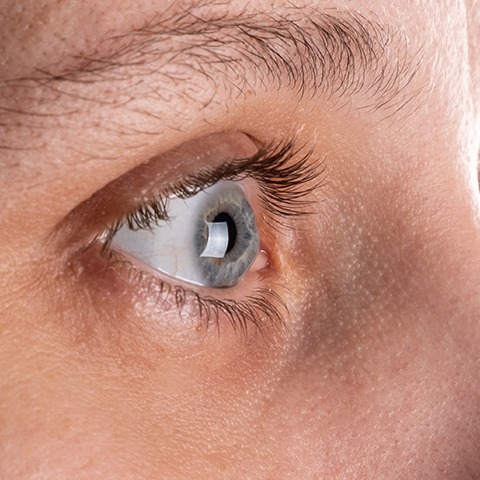Keratoconus Treatment
Keratoconus treatment aims to help stabilise the shape of your cornea. Mild keratoconus is often successfully treated with glasses or specially designed contact lenses. If the condition progresses, corneal collagen cross-linking is an option. This is a minor surgical treatment that slows or stops worsening of the disease.
In cases of advanced keratoconus, surgery may be recommended. Surgery can help to correct the shape of the cornea, improving eyesight.
On this page we explain the condition, the causes, symptoms and how it can be treated.

What is keratoconus?
Keratoconus is an uncommon condition in which the cornea (clear front window of the eye) becomes thin and protrudes. Keratoconus literally means 'cone shaped cornea'. This abnormal shape can cause serious distortion of vision.
What causes keratoconus?
Despite continuing research , the exact cause remains unknown. Research indicates that keratoconus may be caused by an excess of enzymes that break down the proteins within the cornea, causing the cornea to become thin and stretched.
The genetic inheritance of this condition has not clearly been determined. It appears that it may involve a number of different genes. Blood relatives of someone affected with keratoconus have minor changes in their corneas that may indicate that it probably varies both the specific genetic cause, as well as in its expression within a family.
Vigorous eye rubbing can contribute to the disease process. People with keratoconus should absolutely avoid rubbing their eyes. This is sometimes very difficult because some allergies, which cause itchy, irritated eyes, are more commonly associated in patients with keratoconus.
Key points about keratoconus
Mild cases are successfully treated with specially designed contact lenses or glasses.
Allergies and eye rubbing may be part of the cause
Blurring and distorted vision are the earliest symptoms.
What are the symptoms of keratoconus?
Blurring and distortion of vision are the earliest symptoms of Keratoconus. Symptoms usually appear in the late teens or early twenties. The disease will often progress slowly for 10 to 20 years, then stabilise.
In the early stages, vision may be only slightly affected, causing glare, light sensitivity and irritation. Each eye may be affected differently. As the disease progresses and the cornea steepens and scars, vision may become distorted.
A sudden decrease in vision can occur if the cornea swells. The cornea swells when the elastic inner layer of the cornea develops a tiny crack, created by the strain of the cornea’s protruded cone-like shape. The swelling may persist for weeks or months as the crack heals and is gradually replaced by scar tissue.
How is keratoconus treated?
Mild cases are successfully treated with glasses or specially designed RGP contact lenses.
If the condition is processing, a new minor surgical treatment to slow or stop the progression of the disease has become available. This is called corneal collagen cross-linking.
In corneal cross-linking, riboflavin vin (Vitamin B2) drops are soaked into the patient’s cornea then Ultraviolet A light therapy is applied. This induces collagen cross-linking, which has been shown in several studies to stabilise Keratoconus. In a few cases, flattening of the cornea with improved visual acuity has actually occurred.